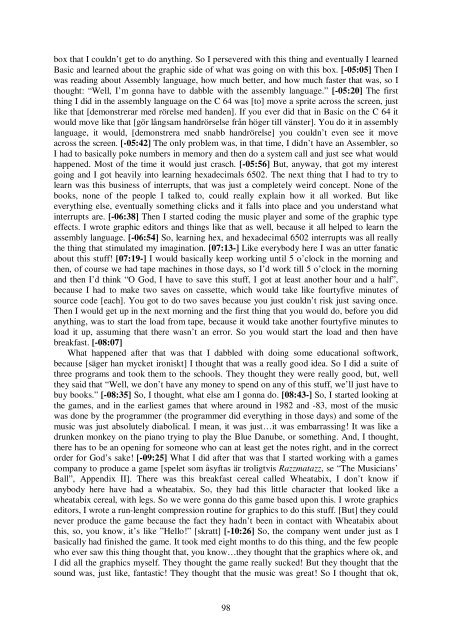Musikaliska uttryck och funktioner i interaktiva v rldar - C64.com
Musikaliska uttryck och funktioner i interaktiva v rldar - C64.com
Musikaliska uttryck och funktioner i interaktiva v rldar - C64.com
Create successful ePaper yourself
Turn your PDF publications into a flip-book with our unique Google optimized e-Paper software.
ox that I couldn’t get to do anything. So I persevered with this thing and eventually I learned<br />
Basic and learned about the graphic side of what was going on with this box. [-05:05] Then I<br />
was reading about Assembly language, how much better, and how much faster that was, so I<br />
thought: “Well, I’m gonna have to dabble with the assembly language.” [-05:20] The first<br />
thing I did in the assembly language on the C 64 was [to] move a sprite across the screen, just<br />
like that [demonstrerar med rörelse med handen]. If you ever did that in Basic on the C 64 it<br />
would move like that [gör långsam handrörselse från höger till vänster]. You do it in assembly<br />
language, it would, [demonstrera med snabb handrörelse] you couldn’t even see it move<br />
across the screen. [-05:42] The only problem was, in that time, I didn’t have an Assembler, so<br />
I had to basically poke numbers in memory and then do a system call and just see what would<br />
happened. Most of the time it would just crasch. [-05:56] But, anyway, that got my interest<br />
going and I got heavily into learning hexadecimals 6502. The next thing that I had to try to<br />
learn was this business of interrupts, that was just a completely weird concept. None of the<br />
books, none of the people I talked to, could really explain how it all worked. But like<br />
everything else, eventually something clicks and it falls into place and you understand what<br />
interrupts are. [-06:38] Then I started coding the music player and some of the graphic type<br />
effects. I wrote graphic editors and things like that as well, because it all helped to learn the<br />
assembly language. [-06:54] So, learning hex, and hexadecimal 6502 interrupts was all really<br />
the thing that stimulated my imagination. [07:13-] Like everybody here I was an utter fanatic<br />
about this stuff! [07:19-] I would basically keep working until 5 o’clock in the morning and<br />
then, of course we had tape machines in those days, so I’d work till 5 o’clock in the morning<br />
and then I’d think “O God, I have to save this stuff, I got at least another hour and a half”,<br />
because I had to make two saves on cassette, which would take like fourtyfive minutes of<br />
source code [each]. You got to do two saves because you just couldn’t risk just saving once.<br />
Then I would get up in the next morning and the first thing that you would do, before you did<br />
anything, was to start the load from tape, because it would take another fourtyfive minutes to<br />
load it up, assuming that there wasn’t an error. So you would start the load and then have<br />
breakfast. [-08:07]<br />
What happened after that was that I dabbled with doing some educational softwork,<br />
because [säger han mycket ironiskt] I thought that was a really good idea. So I did a suite of<br />
three programs and took them to the schools. They thought they were really good, but, well<br />
they said that “Well, we don’t have any money to spend on any of this stuff, we’ll just have to<br />
buy books.” [-08:35] So, I thought, what else am I gonna do. [08:43-] So, I started looking at<br />
the games, and in the earliest games that where around in 1982 and -83, most of the music<br />
was done by the programmer (the programmer did everything in those days) and some of the<br />
music was just absolutely diabolical. I mean, it was just…it was embarrassing! It was like a<br />
drunken monkey on the piano trying to play the Blue Danube, or something. And, I thought,<br />
there has to be an opening for someone who can at least get the notes right, and in the correct<br />
order for God’s sake! [-09:25] What I did after that was that I started working with a games<br />
company to produce a game [spelet som åsyftas är troligtvis Razzmatazz, se “The Musicians’<br />
Ball”, Appendix II]. There was this breakfast cereal called Wheatabix, I don’t know if<br />
anybody here have had a wheatabix. So, they had this little character that looked like a<br />
wheatabix cereal, with legs. So we were gonna do this game based upon this. I wrote graphics<br />
editors, I wrote a run-lenght compression routine for graphics to do this stuff. [But] they could<br />
never produce the game because the fact they hadn’t been in contact with Wheatabix about<br />
this, so, you know, it’s like ”Hello!” [skratt] [-10:26] So, the company went under just as I<br />
basically had finished the game. It took med eight months to do this thing, and the few people<br />
who ever saw this thing thought that, you know…they thought that the graphics where ok, and<br />
I did all the graphics myself. They thought the game really sucked! But they thought that the<br />
sound was, just like, fantastic! They thought that the music was great! So I thought that ok,<br />
98


